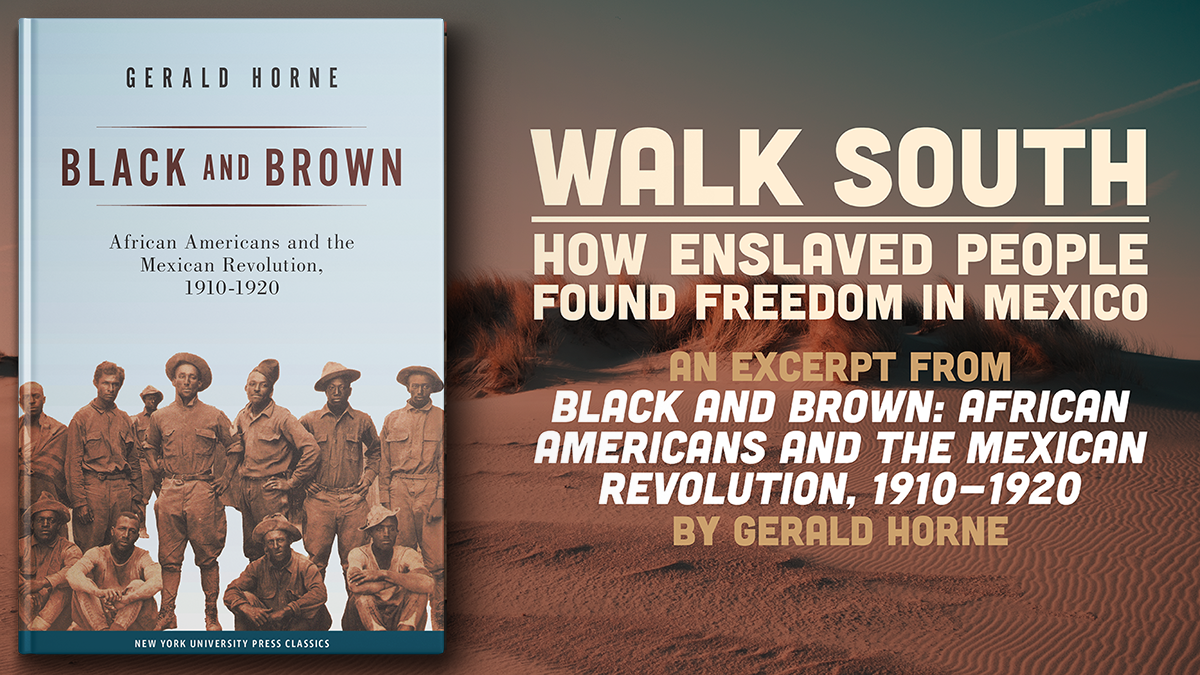An Excerpt from Black and Brown African Americans and the Mexican Revolution, 1910-1920 by Gerald Horne
As Mexico surged to independence from Spain in the early nineteenth century, those of African descent played a prominent role. “Father Miguel Hidalgo, the first leader of the revolt against Spain, issued several decrees in late demanding immediate manumission of all slaves on pain of death.” Theodore G.Vincent writes that the “mule driver Vicente Guerrero was Mexico’s equivalent of the United States’ Washington and Lincoln.” He was a “descendant of the African slaves brought to colonial Mexico, he also had indigenous and Spanish roots.” To be sure, the color line in Mexico was not absent but it was not drawn as sharply as in the United States and, in any case, it was directed in the first place toward the indigenous population. Moreover, given ongoing tensions between the United States and Mexico, it made simple good sense for the latter to befriend the most disenchanted residents of the former.
In 1832, the German visitor Carl Christian Beecher compared the legal status of Afro-Mexicans with African Americans. “These blacks,” he said, “as is known, are free in the Republic of Mexico; which is to say, they enjoy, intimately, the same rights as do the rest of the inhabitants of the state, which is not the case in the United States of North America, where, as a result of the laws, or for prejudices, the blacks are humiliated and pressed down to the category of the lowest level of men.”
Guerrero had used “the September 16 independence celebration in 1829 to issue a presidential edict intended to definitely end the institution of slavery. Guerrero had the federal district official, Jose Maria Tormel, write the decree. Tormel had tried for three years to get the Congress of Mexico to definitively abolish slavery so as to discourage the influx of white settlers to Texas from the United States, who set up slave plantations thanks to special contracts and stood apart from the Spanish-speaking Mexicans.”
Mexican officials “had attempted to abolish the slave system gradually through the Colonization Law of 1824, which emancipated slave children on their fourteenth birthdays. Another law in 1832 forbade the further importation of slaves into Texas, but white colonists”—who viewed this maneuver as a threat worthy of secession—“simply ignored this statute in the face of weak Mexican enforcement.” According to James SoRelle, these colonists were responsible for the fact that despite stubborn competition, “slavery in Texas was worse than in other states.”
In Texas, where the “Old South” merged seamlessly with the “Wild West,” brutal confrontations occurred between masters and enslaved Africans. But unlike their besieged compatriots elsewhere in the country, the latter had a convenient escape hatch on the border. They found it simpler to escape to the south than to the west or north. Interviewed in 1937, ninety-two-year-old San Antonio resident Felix Haywood, a former slave, chortled, “There was no reason to run up north. All we had to do was to walk south, and we’d be free as soon as [we] cross[ed] the Rio Grande. In Mexico you could be free.” The former slave Walter Rimm felt similarly. “All we had to do was walk, but walk south and we’d be free as soon as we crossed the Rio Grande. In Mexico you could be free,” he added with emphasis. “They didn’t care what color you were, black, white, yellow or blue. Hundreds of slaves did go to Mexico”—actually thousands—“and got on all right.We would hear about them and how they were going to be Mexicans. They brought up their children to speak only Mexican [sic].”
U.S. slaveholders recognized early on that abolitionism in Mexico was the open backdoor facilitating the massive flight of capital in the form of enslaved Africans. As early as 1833 the authorities of New Orleans contacted the Mexican government about their effort to recover their “property” which had escaped and found refuge south of the border. Confederate Texans found it hard to forget that enslaved Africans in that state escaped and fought with Mexico against them and their predecessors during the war of the 1830s.
A century later, the famed Negro journalist J. A. Rogers, in writing of “Vicente Guerrero—Liberator of Mexico,” acknowledged, “It would be interesting to know, however, just how large a part the decree [of emancipation] by this Negro president played in the presence of Texas in the American Union today, for the revolt of Texas from the Mexican republic was clearly inspired by the fact that the temper of the Mexican masses was against slavery.” Mexico’s reputation as an abolitionist stronghold may explain why the famed black frontiersman Jim Beckwourth was accused of siding with Mexico during the war.
This hearty pioneer was not alone in his presumed pro-Mexican predilections. James N. Leiker is no doubt accurate in writing that “during most of the nineteenth century, African Americans held Mexicans in higher esteem than other immigrant groups.” “Tejanos even aided run-away slaves by hiding them in homes and churches until they could be shepherded into Coahuila or Tamaulipas.” There was an “overall friendly tone of black-Hispanic interaction.”
Because of the threat of contagion posed by “free West Indian, Northern and Latin American sailors, among others, the port of Galveston too required captains to either deny their black sailors shore leave while in port or to place them in jail for the duration of the ship’s visit.” Though Texas had bolted from Mexico, it could not forget that the noted abolitionist Benjamin Lundy, who published the fierce antislavery polemic “The War in Texas” in 1836, “had received permission from Mexican authorities to establish a colony of free Negroes [in Corpus Christi] prior to the Texas Revolution.” As it turned out, slavery—or rather the “freedom” to engage in slavery—was a “primary cause of the Texas Revolution, affected debates regarding the annexation of Texas” by the United States, and “played a considerable role during the Mexican-American war and in Manifest Destiny generally, and, of course, was the reason why Texas joined the Confederacy at the start of the Civil War.”
…
Certainly, “to many blacks, the words ‘border’ and ‘Mexico’ meant freedom and opportunity.” Texas officials estimated that by 1855 more than four thousand black fugitives, valued at more than $3.2 million, had entered northern Mexico. “By the mid-1850s several Texas counties had passed laws prohibiting Mexicans from communicating with slaves.” In a precursor to the “Plan of San Diego” during the Revolution, Colorado County’s “Anglos hanged three blacks and evicted all Mexicans after uncovering a supposed plot to kill local whites and fight their way to the border.” This occurred in 1856, as regional tensions over slavery skyrocketed. Reportedly, two hundred enslaved Africans were involved. In addition to liquidating most of the Euro-Americans there, they planned to plunder their homes and then escape with sufficient capital to establish a livelihood. The accused were said to have accumulated pistols, knives, guns, and ammunition.
It was in Mexico’s interest to attract U.S. Negroes to their northern border as a firewall against further Euro-American advance; recognizing this, enslaved Africans were inspired to make ever more desperate plans for escape. To say that the border was permeable is an understatement. One reason that there had not been many Negroes in antebellum Brownsville, to cite one example among many, is that before the Civil War slave owners had hesitated to bring their enslaved Africans to such Texas border towns for fear they might scurry across the border. Thousands of enslaved Africans were able to escape into Mexico without trouble because the border, called the Rio Grande in the United States, was little more than a heavy-duty stream. There was “scarcely a bend in [this] river,” said one commentator, that “cannot be forded with the exception of a few feet of swimming.” This also meant that aggressive filibusters from the United States could easily invade Mexico.
In fact, the two phenomena were linked, as filibusters wanted to seize Mexican soil in order to extend the border further south, providing a further buffer for slaveholding and making capital flight more difficult. [The first President of the Republic of Texas] Sam Houston himself “lost” two slaves and he was far from being alone. One filibuster complained acridly in the 1850s, “Something must be done for the protection of slave property in this state. Negroes are running off daily. During the past week, seven slaves left this portion of the country. Let the frontiers of slavery begin to recede and when or where the wave of recession may be arrested God only knows.” Getting Mexico “Americanized and Southernized” was therefore a fervently held objective.
Read More in Black and Brown by Gerald Horne
Honorable Mention for 2005 Gustavus Myers Outstanding Book Award
Brings to light the lives of Black Americans living along the Mexican border during and immediately after the Mexican Revolution
The Mexican Revolution was a defining moment in the history of race relations, impacting both Mexican and African Americans. For Black Westerners, 1910–1920 did not represent the clear-cut promise of populist power, but a reordering of the complex social hierarchy which had, since the nineteenth century, granted them greater freedom in the borderlands than in the rest of the United States.
Despite its lasting significance, the story of Black Americans along the Mexican border has been sorely underreported in the annals of U.S. history. Gerald Horne brings the tale to life in Black and Brown. Drawing on archives on both sides of the border, a host of cutting-edge studies and oral histories, Horne chronicles the political currents which created and then undermined the Mexican border as a relative safe haven for African Americans. His account addresses Black people’s role as “Indian fighters,” the relationship between African Americans and immigrants, and the U.S. government’s growing fear of Black disloyalty. He also considers how the heavy reliance of the U.S. on Black soldiers along the border placed white supremacy and national security on a collision course that was ultimately resolved in favor of the latter.
Mining a forgotten chapter in American history, Black and Brown offers tremendous insight into the past and future of race relations along the Mexican border.


 Six Classics of Queer Literature
Six Classics of Queer Literature